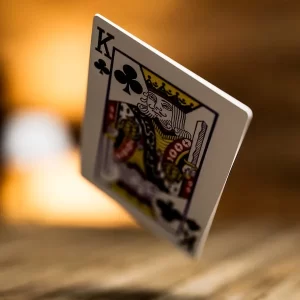“Beyond the Cards: Mastering Poker Tournament Strategy with the Art of Tell-Tale Reading” is a comprehensive guide that delves into the intricacies of poker tournament strategy, focusing specifically on the art of tell-tale reading. This book aims to equip poker players with the necessary skills and knowledge to go beyond the mere analysis of cards and delve into the psychological aspects of the game. By mastering the art of tell-tale reading, players can gain a significant advantage in poker tournaments, allowing them to make more informed decisions and ultimately increase their chances of success.
The Importance of Reading Tells in Poker Tournaments
A tell is a subtle clue or signal that a poker player unknowingly gives off, revealing information about the strength or weakness of their hand. These tells can be physical, such as a twitch or a nervous tic, or they can be verbal, such as a change in tone of voice or a hesitation before making a bet. By carefully observing and interpreting these tells, a skilled player can gain a significant advantage over their opponents.
Reading tells is particularly important in poker tournaments, where the stakes are high and the competition is fierce. In a tournament setting, players are often under immense pressure, which can cause them to reveal more information through their tells. Additionally, as the tournament progresses and players become more familiar with each other’s playing styles, the importance of reading tells becomes even more crucial.
One of the most common tells in poker tournaments is the shaking hand. When a player has a strong hand, they may become nervous or excited, causing their hand to shake slightly. Conversely, when a player has a weak hand, they may try to hide their nerves by keeping their hand steady. By carefully observing a player’s hand, a skilled player can often determine the strength of their hand based on the level of shaking.
Another important tell to watch for is changes in breathing patterns. When a player is bluffing, they may unconsciously hold their breath or breathe more rapidly. On the other hand, when a player has a strong hand, they may breathe more slowly and deeply, trying to appear calm and confident. By paying attention to these subtle changes in breathing, a skilled player can gain valuable insight into their opponent’s hand.
In addition to physical tells, verbal tells can also provide valuable information. For example, a player who hesitates before making a bet may be indicating that they have a weak hand and are unsure whether to proceed. Similarly, a player who speaks more loudly or forcefully when making a bet may be trying to intimidate their opponents and mask the weakness of their hand. By listening carefully to these verbal cues, a skilled player can make more informed decisions and increase their chances of success.
While reading tells is an important skill in poker tournaments, it is not without its challenges. Players are often aware of their own tells and may try to consciously control or mask them. Additionally, some players may intentionally give off false tells in an attempt to deceive their opponents. However, by carefully observing and analyzing a player’s behavior over time, a skilled player can often distinguish between genuine tells and deliberate deception.
In conclusion, reading tells is a crucial skill in mastering poker tournament strategy. By carefully observing and interpreting physical and verbal cues, a skilled player can gain valuable insight into their opponents’ hands and make more informed decisions. While it is not without its challenges, the ability to read tells can give a player a significant advantage in the high-stakes world of poker tournaments. So, the next time you sit down at the poker table, remember to look beyond the cards and pay attention to the subtle clues that can make all the difference.
Mastering Bluffing Techniques in Poker Tournaments
Bluffing is an integral part of poker tournaments, as players attempt to deceive their opponents into believing they have a better hand than they actually do. It is a strategic move that can lead to victory or defeat. However, successful bluffing requires more than just a good poker face. It demands an understanding of human psychology and the ability to read the subtle signals that betray a player’s true intentions.
One of the most effective ways to master bluffing techniques is to observe and analyze the behavior of opponents during a game. Paying close attention to their body language, facial expressions, and betting patterns can provide valuable insights into their hand strength. For example, a player who suddenly becomes more animated or fidgety may be trying to distract others from their weak hand. Conversely, a player who appears calm and composed may be holding a strong hand and trying to lull their opponents into a false sense of security.
Another important aspect of tell-tale reading is understanding the concept of timing. Skilled players often use timing as a tool to deceive their opponents. They may intentionally delay their actions or make quick decisions to create confusion and uncertainty. By carefully observing these timing patterns, players can gain valuable information about their opponents’ intentions and adjust their own strategies accordingly.
Furthermore, it is essential to pay attention to the betting patterns of opponents. A sudden increase in bets or a change in betting behavior can indicate a bluff. For instance, a player who has been consistently betting small suddenly makes a large bet may be trying to intimidate others into folding. On the other hand, a player who has been betting aggressively throughout the game may suddenly become more cautious, signaling a strong hand.
In addition to observing opponents, players must also be mindful of their own behavior. Maintaining a consistent demeanor and avoiding any obvious tells is crucial to successful bluffing. It is important to remain calm and composed, regardless of the strength of one’s hand. Any sudden changes in behavior or facial expressions can give opponents valuable information and compromise one’s bluffing strategy.
Mastering bluffing techniques in poker tournaments requires practice, patience, and a keen eye for detail. It is a skill that can be honed over time, but it is not without its challenges. Players must constantly adapt to the ever-changing dynamics of the game and be prepared to adjust their strategies accordingly.
In conclusion, while bluffing is an essential aspect of poker tournaments, mastering the art of tell-tale reading can give players a significant advantage. By carefully observing opponents’ behavior, timing, and betting patterns, players can gain valuable insights into their opponents’ intentions and adjust their own strategies accordingly. Additionally, maintaining a consistent demeanor and avoiding obvious tells is crucial to successful bluffing. With practice and perseverance, players can elevate their poker game to new heights and increase their chances of success in the thrilling world of poker tournaments.
Analyzing Hand Ranges for Effective Decision Making in Poker Tournaments
Poker tournaments are a thrilling battleground where players must navigate through a maze of uncertainty and deception. While mastering the art of reading hand ranges may seem like an insurmountable task, it is a crucial skill that can greatly enhance a player’s chances of success. In this article, we will delve into the world of analyzing hand ranges and explore how it can lead to effective decision making in poker tournaments.
To understand the concept of hand ranges, one must first grasp the fundamental principle that every action a player takes at the poker table provides valuable information. From the initial bet to the final showdown, each move is a piece of the puzzle that can help decipher the strength of an opponent’s hand. By carefully observing these actions, players can begin to construct a range of possible hands that their opponents may hold.
Analyzing hand ranges requires a keen eye for detail and a deep understanding of the game. It involves considering factors such as position, stack sizes, and previous betting patterns. For example, a player who raises from early position is likely to have a stronger hand than someone who raises from late position. Similarly, a player with a short stack is more likely to go all-in with a wider range of hands in an attempt to double up.
Transitional phrase: With this knowledge in mind, players can start narrowing down their opponent’s hand range and making more informed decisions.
One effective technique for analyzing hand ranges is to categorize them into different groups based on their strength. This can be done by assigning a range of hands to each category, such as premium hands, strong hands, medium hands, and weak hands. By doing so, players can quickly assess the likelihood of their opponent holding a particular type of hand and adjust their strategy accordingly.
Transitional phrase: However, it is important to note that hand ranges are not set in stone and can vary depending on the player’s style and tendencies.
Another crucial aspect of analyzing hand ranges is considering the player’s tendencies and playing style. Some players are more aggressive and tend to play a wider range of hands, while others are more conservative and only play premium hands. By observing these tendencies, players can gain valuable insights into their opponents’ likely hand ranges and exploit any weaknesses.
Transitional phrase: Armed with this information, players can make more accurate decisions and increase their chances of success in poker tournaments.
It is worth mentioning that analyzing hand ranges is not an exact science and requires a combination of skill, experience, and intuition. It is a continuous process that evolves throughout the course of a tournament as new information becomes available. As the game progresses, players must constantly reassess their opponents’ hand ranges and adjust their strategy accordingly.
Transitional phrase: In conclusion, analyzing hand ranges is a vital skill that can greatly enhance a player’s decision-making abilities in poker tournaments. By carefully observing their opponents’ actions and considering factors such as position and playing style, players can construct a range of possible hands and make more informed decisions. While it may take time and practice to master this art, the rewards are well worth the effort. So, the next time you find yourself at a poker table, remember to look beyond the cards and delve into the fascinating world of hand range analysis.
Strategies for Managing Your Chip Stack in Poker Tournaments
Poker tournaments are a thrilling and competitive arena where players battle it out for the ultimate prize. While mastering the art of reading your opponents’ tells is crucial, managing your chip stack effectively is equally important. In this section, we will explore some strategies that can help you make the most of your chip stack in poker tournaments.
One of the key aspects of managing your chip stack is understanding the concept of chip value. In a tournament, chips are not just a means of keeping score; they represent your survival in the game. Each chip lost brings you closer to elimination, while each chip gained gives you a chance to stay in the game. Therefore, it is essential to value your chips and make strategic decisions based on their worth.
One strategy for managing your chip stack is to play conservatively in the early stages of the tournament. This approach allows you to preserve your chips and avoid unnecessary risks. By playing tight and selectively entering pots, you can minimize the chances of losing a significant portion of your stack. This conservative approach also gives you an opportunity to observe your opponents and gather valuable information about their playing styles.
As the tournament progresses and the blinds increase, it becomes crucial to adjust your strategy accordingly. With the blinds eating away at your stack, you need to be more aggressive and take calculated risks. Look for opportunities to steal blinds and antes, especially when you are in late position. By capitalizing on the tight play of your opponents, you can accumulate chips without having to show your cards.
Another important aspect of managing your chip stack is understanding the concept of stack-to-pot ratio (SPR). The SPR is a measure of how many times the effective stack size (yours and your opponent’s) can fit into the current pot. It helps you determine the optimal bet sizing and the level of commitment you should have in a hand. A high SPR indicates a deep-stacked situation, where you can afford to play more speculative hands. Conversely, a low SPR suggests a shallow-stacked scenario, where you should focus on playing strong hands aggressively.
In addition to the conservative and aggressive approaches, it is essential to be adaptable and flexible in your chip management strategy. Every poker tournament is unique, with different players, table dynamics, and blind structures. Therefore, it is crucial to assess the situation constantly and adjust your strategy accordingly. If you find yourself with a large chip stack, you can put pressure on your opponents and force them to make difficult decisions. On the other hand, if you are short-stacked, you may need to take more risks and look for opportunities to double up.
In conclusion, managing your chip stack effectively is a crucial aspect of poker tournament strategy. By understanding the value of your chips, playing conservatively in the early stages, adjusting your strategy as the blinds increase, and considering the stack-to-pot ratio, you can maximize your chances of success. Remember, poker is not just about the cards; it is about making strategic decisions based on the information available to you. So, go beyond the cards and master the art of tell-tale reading to become a formidable force in poker tournaments.
Psychological Factors to Consider in Poker Tournament Strategy
Psychological factors play a crucial role in poker tournament strategy. Understanding the psychology of your opponents can give you a significant advantage at the table. One of the first things to consider is the concept of “tilt.” Tilt refers to a state of emotional or mental frustration that can cause a player to make irrational decisions. Recognizing when your opponents are on tilt can help you exploit their weaknesses and increase your chances of winning.
Another psychological factor to consider is the concept of “table image.” Table image refers to the way other players perceive you at the table. If you have a tight and conservative image, other players may be more likely to fold when you make a big bet. On the other hand, if you have a loose and aggressive image, other players may be more likely to call or raise your bets. Understanding and manipulating your table image can give you a significant advantage in poker tournaments.
In addition to tilt and table image, it is important to consider the concept of “range reading.” Range reading refers to the ability to accurately assess the range of hands that your opponents may have based on their betting patterns and other tells. By narrowing down the possible hands that your opponents may have, you can make more informed decisions and increase your chances of winning.
Another psychological factor to consider is the concept of “position.” Position refers to where you are seated in relation to the dealer button. The later your position, the more information you have about your opponents’ actions before you have to make a decision. This can give you a significant advantage in poker tournaments, as you can make more informed decisions based on the actions of your opponents.
Finally, it is important to consider the concept of “emotional control.” Poker can be an emotional game, and it is easy to let your emotions get the best of you. However, emotional control is crucial in poker tournaments. By staying calm and composed, you can make more rational decisions and avoid making costly mistakes.
In conclusion, mastering poker tournament strategy goes beyond simply playing the cards. Understanding the psychological factors at play can give you a significant advantage at the table. By recognizing tilt, manipulating your table image, range reading, understanding position, and maintaining emotional control, you can increase your chances of success in poker tournaments. So, the next time you sit down at the poker table, remember to look beyond the cards and focus on the psychological aspects of the game. “Beyond the Cards: Mastering Poker Tournament Strategy with the Art of Tell-Tale Reading” is a valuable resource for poker players looking to enhance their tournament strategy. The book delves into the art of tell-tale reading, providing insights and techniques to help players gain an edge in reading their opponents’ intentions and making informed decisions. By combining traditional poker strategies with the skill of tell-tale reading, players can improve their overall performance and increase their chances of success in poker tournaments.




